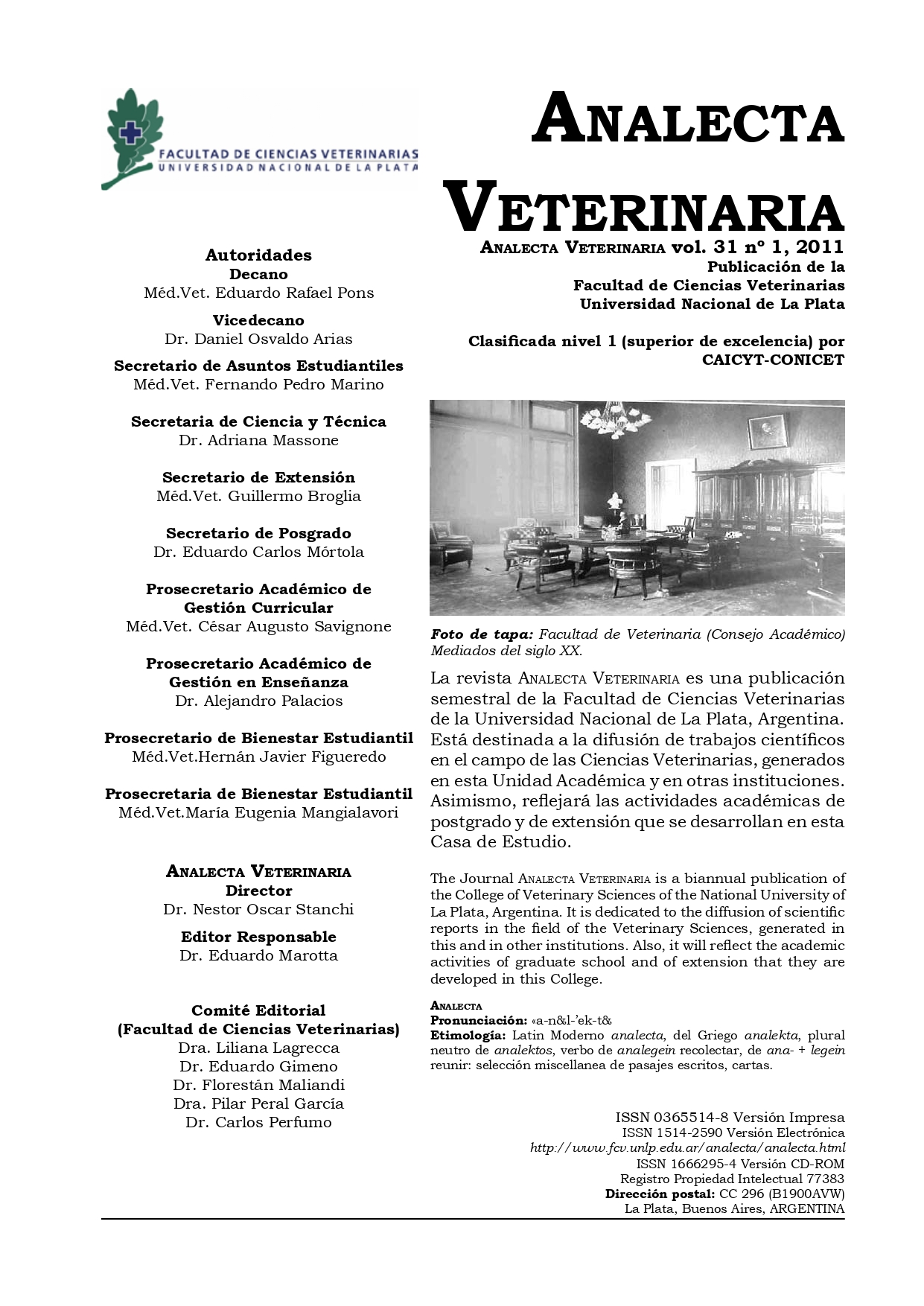Micobacterias aisladas de especies domésticas y silvestres durante 2004-2008
Palabras clave:
Mycobacterium, notificación, animales, silvestres,, domésticosResumen
La identificación de la tuberculosis bovina y su diferenciación de las micobacteriosis es fundamental durante el diagnóstico. Es por eso que los laboratorios especializados en micobacterias son de suma importancia en los servicios de salud pública y salud animal. El objetivo de la presente investigación es diferenciar Mycobacterium bovis de micobacterias no tuberculosas en cepas cultivadas a partir de especies domésticas y silvestres de siete provincias de Argentina durante 2004-2008. La diferenciación se basó sobre las pruebas bioquímicas, las características fenotípicas y el “spolygotyping” de M. bovis. Con la identificación bioquímica y fenotípica se detectaron 20 cepas de M. bovis, 18 de las cuales fueron confirmadas mediante “spolygotyping”, y 34 cepas de micobacterias no tuberculosas. Trece especies fueron caracterizadas y todas ellas fueron agrupadas considerando el riesgo biológico y el potencial patógeno notificado en seres humanos y/o animales. En este trabajo se han logrado avances en el diagnóstico de tuberculosis y micobacteriosis en medicina veterinaria. En este área el diagnóstico habitualmente se basa sobre la observación micro y macroscópica de los tubérculos y los resultados de la intradermorreacción. Estos avances son importantes porque la tuberculosis zoonótica aún es un problema de salud pública en América Latina.
Referencias
Rastogi N, Legrand E, Sola C. The mycobacteria: an introduction to nomenclature and pathogenesis. Rev sci tech Off int Epiz 2000; 20 (1): 21-54.
Leao SC, Martin A, Mejia GI, Palomino JC, Robledo J, Telles MAS, Portaels F, 2005; Practical handbook for the phenotypic and genotypic identification of mycobacteria. Available: http://www.esmycobacteriology. eu/Inco.htm. Accessed 16th October 2008.
Good RC, Shinnick TM. Mycobacterium. In: Topley & Wilson´s. Microbiology and microbial infections. Volume 2. Systematic bacteriology. Arnold Ed. Great Britain, 1998; p. 549-574.
de Kantor IN. Micobacterias. In: Microbiología Veterinaria. Ed. Stanchi et. al. Editorial Intermédica. Buenos Aires (Argentina), 2007; p. 300-306.
Rybniker J, Kramme S, Small PL. Host range of 14 mycobacteriophages in Mycobacterium ulcerans and seven other mycobacteria including Mycobacterium tuberculosis – application for identification and susceptibility testing. J Med
Microbiol 2005; 55: 37–42.
de Kantor IN. Tuberculosis: Aislamiento e Identificación de Micobacterias. Centro Panamericano de Zoonosis-OPS-OMS. Buenos Aires (Argentina), 1973; p. 1-48.
de Kantor IN. Tuberculosis: Bacteriología de la Tuberculosis. Centro Panamericano de Zoonosis-OPSOMS. Buenos Aires (Argentina), 1979; p. 1-63.
Jorge MC, Alito A, Bernardelli A, Canal A M, Cataldi A, Cicuta ME, Gentile F, Kistermann JC, Magnano G,Martínez Vivot ME, Oriani DS, Paolicchi FA, Pérez AM, Romano MI, Schneider M, Torres P, Zumárraga MJ. Manual de Diagnóstico de Micobacterias de importancia en Medicina Veterinaria. Comisión Científica de Micobacterias Asociación Argentina de Veterinarios de Laboratorios de Diagnóstico. Santa Fe (Argentina),2005; p. 1-132.
de Kantor IN, Kim SJ, Frieden T, Laszlo A, Luelmo F, Norval PY, Rieder H, Valenzuela P, Weyer K. Laboratory services in tuberculosis control. Culture. Part III. WHO. Biella (Italy), 1998; p. 1-95.
de Kantor IN, Kim SJ, Frieden T, Laszlo A, Luelmo F, Norval PY, Rieder H, Valenzuela P, Weyer K. Laboratory services in tuberculosis control. Microscopy. Part II. WHO. Biella (Italy), 1998; p. 1-61.
de Kantor IN, Bernardelli A. Identificación preliminar de micobacterias aisladas en muestras de origen humano y animal. Rev Med Vet 1987; 68 (2): 86-90.
Thorel MF, Krichevsky M, Lévy-Frébault VV. Numerical taxonomy of mycobactin-dependent mycobacteria, emended description of Mycobacterium avium subsp. avium subsp. nov., Mycobacterium avium subsp. paratuberculosis subsp. nov. and Mycobacterium avium subsp. silvaticum subsp. nov. Int J Syst Bacteriol 1990; 40 (3): 254-260.
Lévy Frebault VV, Portaels F. Proposed minimal standards for the Genus Mycobacterium and description of new
lowly growing Mycobacterium species. Int J of Syst Bacteriol 1992; 42 (2): 315-323.
Kamerbeek J, Schouls L, Kolk A, van Agterveld M, van Soolingen D, Kuijper S, Bunschoten A, Molhuizen H, Shaw R, Goyal M, van Embden J. Simultaneous detection and strain differentiation of Mycobacterium tuberculosis for diagnosis and epidemiology. J Clin Microbiol 1997; 35: 907–914.
Torres PM. Situación de la tuberculosis bovina en la Argentina. In: Temas de zoonosis II. Asociación Argentina de Zoonosis. Buenos Aires (Argentina), 2004; p. 235-242.
de Kantor IN, Ambroggi M, Poggi S, Morcillo N, Da Silva Telles MA, Osório Ribeiro M, Garzón Torres MC, LLerena Polo C, Ribón W, García V, Kuffo D, Asencios L, Vásquez Campos LM, Rivas C, de Waard JH. Human Mycobacterium bovis infection in ten Latin American countries. Tuberculosis 2008; 88: 358–365.
de Lisle GW, Mackintosh CG, Bengins RG. Mycobacterium bovis in free-living and captive wildlife, including farmed deer. Rev sci tech Off int Epiz 2001; 20 (1): 86-111.
Wilkins MJ, Meyerson J, Bartlett PC, Spieldenner SL, Berry DE, Mosher LB, Kaneene JB, Robinson-Dunn B, Stobierski MG, Boulton ML. Human Mycobacterium bovis Infection and Bovine Tuberculosis Outbreak, Michigan, 1994–2007. Emerg Infect Dis 2008; 14 (4): 657-660.
Zumárraga M J, Martín C, Samper S, Alito A, Latini O, Bigi F, Roxo E, Cicuta M E, Errico F, Castro Ramos M, Cataldi A, van Soolingen D, Romano MI. Usefulness of spoligotyping in the molecular epidemiology of Mycobacterium bovis related infections in South American countries. J Clin Microbiol 1999; 37 (2): 296-303.
Cousins DV. Mycobacterium bovis infection and control in domestic livestock. Rev sci tech Off int Epiz 2001; 20 (1): 71-85.
Bercovier H, Vincen V. Mycobacterial infections in domestic and wild animals due to Mycobacterium marinum, M. fortuitum, M. chelonae, M. porcinum, M farcinogenes, M. smegmatis, M. scrofulaceum, M. xenopi, M kansasii, M simiae and M. genavense. Rev sci tech Off int Epiz 2001; 20 (1): 265-290.
Hines ME II, Kreeger JM, Herron AJ. Mycobacterial infections of animals: pathology and pathogenesis. Lab Anim Sci 1995; 45 (4): 334-350.
Schultze WD, Stroud BH, Brasso WB. Dairy herd problem with mastitis caused by a rapidily growing Mycobacterium species. Am J Vet Res 1985; 46 (1):42-47.
Kazda J, Cook BR. Mycobacteria in pond waters as a source of non-specific reactions to bovine tuberculin in New Zealand. N Z Vet J 1988; 36: 184-188.
Cooney R, Kazda J, Quinn J, Cook B, Müller K, Monaghan M. Environmental mycobacteria in Ireland as a source of non-specific sensitisation to tuberculins. Ir Vet J 1997; 50: 370-373.
Falkinham JO III. Epidemiology of infection by nontuberculous mycobacteria. Clin Microbiol Rev 1996; 9 (2): 177–215.
Descargas
Publicado
Número
Sección
Licencia
Los autores/as conservan los derechos de autor y ceden a la revista el derecho de la primera publicación, con el trabajo registrado con la licencia de atribución de Creative Commons, que permite a terceros utilizar lo publicado siempre que mencionen la autoría del trabajo y a la primera publicación en esta revista.

Analecta Veterinaria por Facultad de Ciencias Veterinarias se distribuye bajo una Licencia Creative Commons Atribución-NoComercial-SinDerivar 4.0 Internacional.




























